|


| |
Target Types
What Type of things are there in the sky?
Here are some additional links for urban observers: Urban
Skies
(photos are somewhat representative of views through a small scope in medium
skies)
The Variables:
Moon
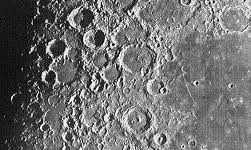 |
Great Target even in very bright skies. Very bright, you
will want to use a Moon filter when it's anything thicker than a crescent
or a quarter (it will destroy your night vision).
When the moon is at a phase other than Full (or near full), the shadows
at the terminator make it easy to see detail in the terrain: craters,
mountains, valleys. At Full Moon, shadows are not visible and the
terrain looks very two-dimensional.
When looking for Deep Sky Objects, avoid bright moonlit nights. |
Planets
 |
Jupiter and Saturn are Great Targets even in very bright
skies. Jupiter's bands and its four largest moons are almost always
visible, even in a small scope. Saturn's rings are stunning, even in
a small scope, and its large moon Titan is easily seen. |
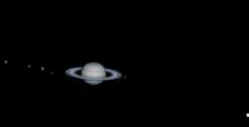 |
Mars is bright but it lacks readily-resolvable features in a small
scope. When it's close to the earth (every 26 months) dark grey surface
details can be seen on its orange/salmon-colored disc and a polar ice cap
can be seen - but only through large scopes.
Venus will show a phase (like the moon) but no details; it is always near the
Sun (a dawn or dusk "star"). Mercury is like Venus but harder to
observe (smaller and much closer to the Sun).
Uranus will show a blue featureless disc in larger scopes, but is hard to
find.
Neptune looks like a faint star even in the largest scopes.
Conjunctions
Since the Moon and Planets move around, they pass each other and bright
stars. These events are generally best viewed with the naked eye or
binoculars. Occasionally a conjunction will be tight enough to view
through the narrow view of a telescope.
Jupiter's and Saturn's Moons
Jupiter's and Saturn's large moons are visible in telescopes and vary in
position from night to night and sometimes from hour to hour (Io in particular
has a very short orbit around Jupiter). Sometimes the moons transit the
planet, are eclipsed by it or cast its shadow across it. These events are
predictable and times are available on the internet. The blurb below is
from an event that occurred during Curie Elementary's Annual Stargazing Night, Feb 3
In addition to the "generic" winter sky highlights, an interesting
event will be taking place while the scopes will be gazing skywards:
Jupiter's moon Europa will be transiting Jupiter's disc and at 7:30 Europa's
shadow will start to creep across Jupiter's disc. Generally, both Europa
and its shadow should be visible. The major variable here is how close to
the horizon Jupiter will be at 7:30 pm. The shadow will more than likely
be visible; Europa itself might be hard for little eyes to pick out.
Here's a picture and a simulation:
The Sun
First, never look at
the sun without an appropriate filter in place. Instant and permanent eye
damage can occur.
| The sun is a great observing target, if you have
appropriate equipment.
Observing the sun can be done from anywhere: urban light pollution
and dirty urban air have little on what you can see.
While you're only looking at one celestial object, the sun's activity
changes from day to day.
Sunspots vary in number and size.
Hydrogen-alpha viewing (show to the right) also allows viewing of
other solar features, such as Prominences, Flares, Sunspots, Active
Regions and Filaments.
The sun rotates once every 25 days or so. Over the course of a
week you can see the features move across the disk.
Click here for more info on Solar
Observing. |
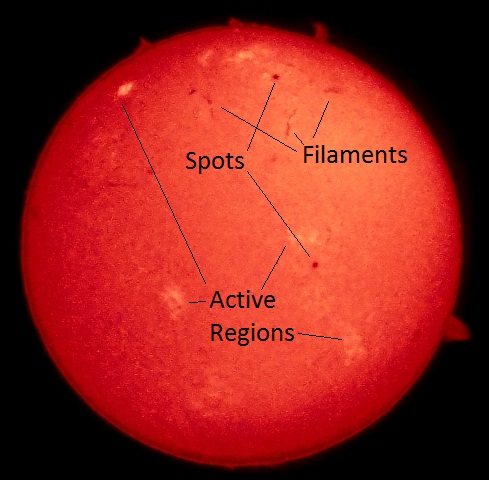 |
The Deep Space Constants
I'll discuss in rough order of what is good from a bright urban sky with a
small scope.
Stars
Single, normal stars are generally not more interesting through a telescope
than with the naked eye. Stars are so far away that even the largest
telescopes fail to resolve them as anything other than a pinpoint of light (no
discs are visible).
Multiple Stars
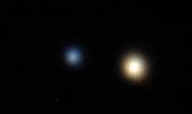 |
Most stars are part of a multiple-star system. There
are many multiple star systems that are visible even from bright
skies. Many observers love to "split" double stars, seeing
if there equipment and their eye can discern two stars that are very close
together or of very different brightnesses.
In addition to true multiple star systems, some unrelated stars appear
close together because they're in the same direction relative to earth;
these are called "optical binaries". |
Variable Stars
Some stars vary in brightness, some enough to notice over a predictable
period of time. Familiarity with the sky is critical to appreciate the
variation.
Open Star Clusters
 |
Star Clusters also suffer relatively little
from a bright sky. Some are quite visible with the naked eye.
Binoculars and small scopes are excellent to see dimmer members of the
cluster. |
| The famous Double-Cluster. |
Globular Clusters
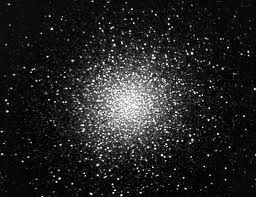 |
Globular Star Clusters are some of the most
impressive of Deep Sky Objects visible from light-polluted skies.
Globular Cluster are tight balls of up to a million stars that are
scattered outside the disk of our galaxy. They are visible in
binoculars and small scopes. Larger scopes allow you to
resolve the core into individual stars. |
| The Great Hercules Globular Cluster. |
The Milky Way
Easily visible by naked eye in a moderately dark site (out of the suburbs),
the Milky Way is often mistaken as a band of clouds. In a way it is: a
permanent massive cloud of stars and gas. We are smack in the middle of
the disk of our galaxy and the Milky Way surrounds us in a loop that circles the
sky. From a dark site, sweeping through the Milky Way with binoculars or a
telescope is awe-inspiring, full of all sorts of deep sky goodies.
Galaxies
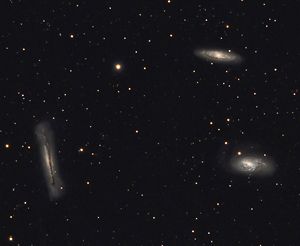 |
Galaxies are largest and most
intellectually-impressive objects to be seen in the sky. Visually,
however, they are dusty smudges, except for a handful when seen from dark
skies. Knowing that the smudge you are looking at contains 100
billion suns is pretty awe-inspiring, though. The
Andromeda Galaxy can be see with the naked eye from a dark sight and is
visible with binoculars and a small scope from bright skies. Other
galaxies are visible from suburban, skies, but the darker the sky, the
better the view. M81 and M82 are favorite urban targets, as one is
face-on (round smudge) and the other is edge-on (cigar-shaped). They
are both visible in the same view. |
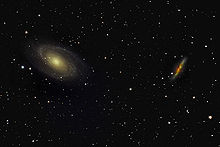 |
| Leo Triplets |
M81 and M82 |
Nebulas
 |
We've all see those majestic Hubble shots of "The
Pillars of Creation" and other nebulas. Looking at nebula
through a small telescope from urban skies is decidedly less
majestic. Nebulas tend to be low brightness, low contrast grey
objects. They do not have the photon energy to fire off our retina's
color receptors. They look like small static clouds
("Nebula" is Latin for cloud). There are some exceptions
to the "Not overly impressive" rule, though, namely the Orion
Nebula. It's found as the middle "star" in the sword under
Orion's easily-found belt. Dark skies and big scopes bring out more
nebulas and their details. |
Planetary Nebulas
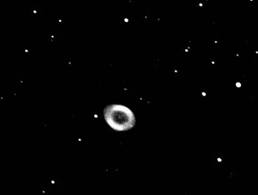 |
Planetary Nebulas are stars blowing off their
atmospheres. There are a number that are visible from urban skies. |
Google "Messier Objects" for this list of 109 cool deep sky objects.
|